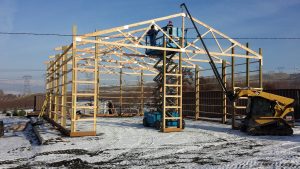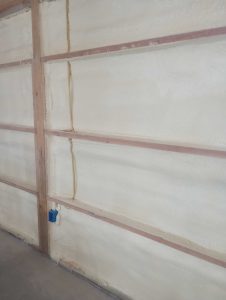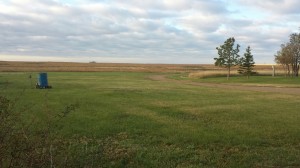“Except where erected on solid rock or otherwise protected from frost, foundation walls, piers and other permanent supports of buildings and structures larger than 400 square feet in area or 10 feet in height shall extend below the frost line of the locality, and spread footings of adequate size shall be provided where necessary to properly distribute the load within the allowable load-bearing value of the soil.”
Yeah, right….and what did this tell you?
Frost heave can do nasty things to pole buildings with improper or inadequate footing designs. When pressure preservative treated columns are embedded to an inadequate depth, or are encased in concrete where the holes are conical (wider at the top than at the bottom), they can be prone to heave.
 In winter, ground freezes from the top of the soil downward. The depth of frost penetration depends on soil type, the severity of the winter, the amount of water in the soil and depth of an insulating blanket of snow.
In winter, ground freezes from the top of the soil downward. The depth of frost penetration depends on soil type, the severity of the winter, the amount of water in the soil and depth of an insulating blanket of snow.
The frost depth varies by region. In frigid northern climates, the frost depth can be 60 inches or more, whereas a warmer southern state frost may not even be an issue.
Your local building department can be called and asked what the frost depth requirement is. Then dig the footing holes so that the bottoms of the pole building footings are at or below the frost depth.
The mechanics of frost heave are complex, but here’s a quick primer. Water in the surrounding soil collects and freezes into thin layers of frost called “ice lenses.”
When water freezes, it expands (think of how ice cubes have a dome shape above the original water level in the ice cube tray). Ice exerts a pressure of about 50,000 lbs. per square inch—enough force to lift even a large building. A pole barn on inadequate footings doesn’t stand a chance.
The reason buildings don’t always return to their original height is that surrounding dirt sometimes fills in under the footing while it’s lifted.
Heavy clay soils don’t drain well, so they tend to have more frost heave problems than sandy, well-drained ones. But even if pole building footings are deep enough, ice lenses can latch onto the rough surfaces of wood and concrete and lift footings and posts from the side. This potential problem can be alleviated by increasing the diameter at the bottom of the holes.
Bottom line: make sure your pole building footing design extends below the frost line. Frost acts randomly, so unless you are planning on selling tickets to “pole building at a slant”, make sure your building stays…exactly where you put it.










Nice information about frost depth.